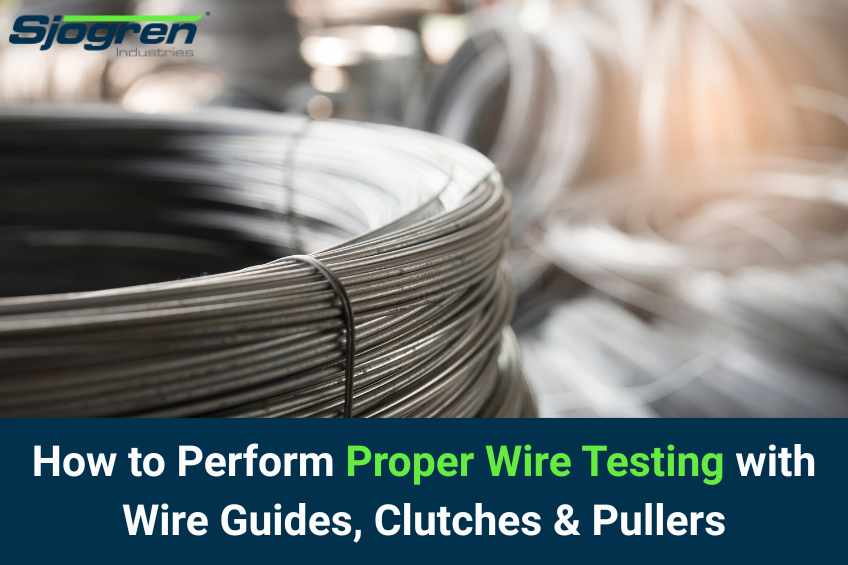What Does Factory 4.0 Mean for Your Shop Floor?

Customers want shorter lead times, tighter tolerances, and cleaner finishes. Factory 4.0 is a practical way to connect the steps you already run, capture the right data, and repeat the settings that produce good parts. In this blog, we’ll cover what Factory 4.0 means on a wire shop floor, how to standardize setups, and where connected tools make the biggest impact.
You’ll see how to track assets like wire guides and wire hooks, tighten up repeatability with a wire straightening tool and modern wire straighteners, and improve safety and throughput with smarter wire pulling practices. We’ll also outline a simple roadmap to start small, measure results, and scale what works so your team spends less time fighting variables and more time shipping good parts.
What Is Factory 4.0?
Factory 4.0 connects machines, tools, and teams so every step of production is visible, repeatable, and easy to improve. Think sensors on key stations, PLC tags feeding a central database, and dashboards that show what is running, what needs service, and which settings produced the best parts. Barcodes or RFID tie jobs to recipes, while simple rules kick off alerts if tension, speed, or temperature drift out of range.
The result is fewer surprises and faster decisions on the floor. You keep the processes that already work, add the data you are missing, and close feedback loops so good settings are saved and reused. Even everyday hardware becomes trackable, from setup fixtures to spare rolls, which cuts guesswork during changeovers. Factory 4.0 is less about buying a roomful of new machines and more about stitching together what you have, then proving gains in quality, uptime, and throughput.
The Digital Backbone: Data In, Insights Out
Start by getting good data out of machines and into a place you can use. PLC tags should map to plain names, recipes should live in one source of truth, and your MES or ERP should receive job, speed, tension, and scrap without manual retyping. Build simple dashboards that answer three questions fast: what is running, what needs attention, and what did we learn. Track assets with barcodes or RFID so a supervisor can see which wire guides and wire hooks are on the line and how long they have been in service.
The payoff is practical. Changeovers get faster because the last good recipe is one click away. Traceability improves because every lot ties to its settings and results. Preventive alerts fire when tension drifts or downtime spikes. You get fewer after-the-fact surprises and more real-time decisions that keep orders moving.
Straightening Gets Smart: From Setup to Repeatability
Pick a wire straightening tool that matches reality on your floor. Start with the diameter range, expected line speed, and the shapes you run. Choose a roll count and layout that gives you control without constant tweaking. Quick-release levers and clear reference marks help you return to a proven setup in minutes instead of guessing at gap and pressure. Treat rolls like consumables with a plan.
Keep a labeled spare set for your top products, store them clean, and log hours so swaps happen before quality slips. Train operators to record the last good recipe and the first-piece check, then lock it in for the next run. Good habits turn wire straighteners into repeaters: same settings, same results, less scrap. The outcome is faster changeovers, fewer mystery bends, and a process that stays in control even as orders and alloys change.
Guiding and Handling: Protect Your Wire Finishes
A smooth line starts with the right wire guides. If the entry guide is sized well and aligned, the product rolls in clean, stays centered, and you avoid those tiny scuffs that show up later. Think of wire guides as your first quality checkpoint: set the height, confirm the roll condition, and lock it in before you press go.
The same idea applies to wire hooks. Match the hook to the load and the block style so you’re pulling, not fighting. Use wire hooks with swivel action where twist creeps in, and keep a consistent spec so operators always know what to grab. Do that, and setup gets quicker, finishes stay clean, and changeovers feel a lot less dramatic.
Pulling With Confidence: Control, Safety, Uptime
Reliable wire pulling starts with the right tool for the job. Match the puller to your force range and wire diameter so the grip is firm without crushing. Light-duty grips handle fine diameters, medium-duty covers daily production, and heavy-duty is for die pulls and big loads.
Build a simple checklist that operators follow every time: verify jaw condition, clean contact faces, confirm chain and hook ratings, test open and close before you load. Add a quick jaw bite check on first pull, then log it. If you use thumb-release or clevis options, train on when each applies and keep spare jaws at the station. These small habits protect the wire, keep people safe, and keep uptime where you want it.
Testing That Proves It: Pointers, Wraps, Torsion
Good testing starts with clean prep. Use a wire pointer to size the lead so samples feed dies smoothly and you are not fighting an out-of-round tip. For spring and coated wire, a wrap test quickly shows cracks or flaking before they reach a customer. Add a reverse bend check to spot coating or metal fatigue under repeated flex.
Finish with a torsion test to catch brittleness, inclusions, and hidden seams early, then compare twist counts to your spec. Keep fixtures labeled, mandrels organized by diameter, and record results in a simple log tied to heat number and line. If any sample fails, quarantine the lot, swap jaws if worn, and retest. A steady routine like this turns testing into a fast, reliable gate for quality.
Brakes, Clutches, and Line Control That Keep Pace
Smooth lines start with steady tension. Use hysteresis brakes on payoff to keep force consistent as spool diameter drops, and add simple scale marks so operators can repeat settings shift to shift. Eddy-current clutches can soften starts and stops, which protects dies, capstans, and guides.
Tie these settings to your product sheet so changeovers are quick and repeatable. Stable tension also helps wire straighteners do their best work, since rolls see fewer shocks and the wire stays centered. Keep a short checklist: verify tension setpoint, confirm clutch response, test a short pull, then log the numbers for your next run.
Key Takeaways
- The path to Factory 4.0 starts with clean data and repeatable setups, not huge capital buys.
- Right-sized wire guides and correctly matched wire hooks protect finish quality and cut setup time.
- A well-chosen wire straightening tool and tuned wire straighteners drive consistency that shows up in lower scrap and smoother changeovers.
- Standardized wire pulling procedures with clear jaw checks reduce breakage and protect capstans.
- Routine verification with a quick wrap check and a targeted torsion test catches brittleness and seams before they turn into downtime.
- Simple tension controls and calibrated brakes keep your line stable as speeds and diameters change.
Next Steps
- Pick one product family and document today’s best-known settings for guides, hooks, tension, and speeds.
- Create a one-page setup sheet with photos, jaw specs, and pull-force ranges. Post it at the machine.
- Add footage-based checks after straightening and log roll positions to spot drift early.
- Build presets for your wire straightening tool by material and diameter, then train operators to use them.
- Stand up a basic dashboard that shows tension, footage, scrap, and unplanned stops so the team can act fast.
- Schedule quarterly audits of guides, hooks, and puller jaws, and include a short torsion test on critical parts.
If you’re ready to modernize your wire bending and testing process, Sjogren can help. From precision wire guides and wire hooks to proven wire straighteners, pullers, and testing tools, our team will help you standardize setups, stabilize tension, and cut downtime. Contact us today or follow us on LinkedIn to start your Factory 4.0 plan with a practical, stepwise upgrade path.



